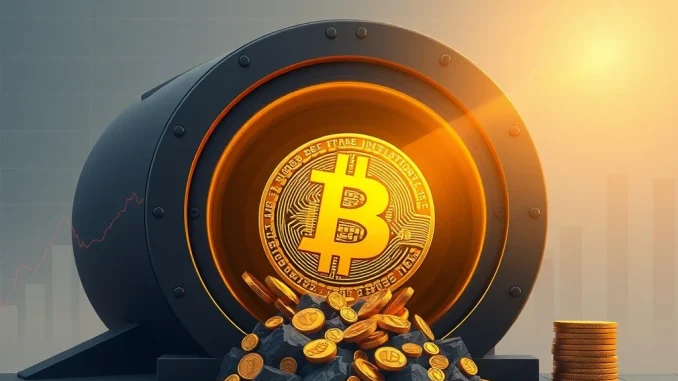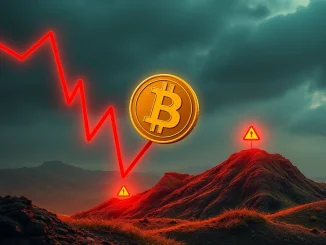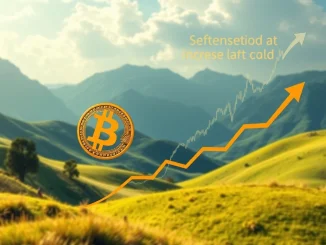
Are you closely watching the Bitcoin charts, wondering if the next big dip is just around the corner? For many, the cryptocurrency market can feel like a roller coaster, but recent insights suggest a surprising level of stability for the world’s leading digital asset. A prominent voice in the crypto space, Matt Mena, a crypto research strategist at 21Shares, has offered a compelling Bitcoin price outlook that might ease some of those fears. He posits that a sharp short-term decline in Bitcoin (BTC) is unlikely, and his reasoning is rooted in a fundamental shift in market dynamics: surging demand meeting tightening supply. This perspective offers a fascinating counter-narrative to the usual volatility discussions, suggesting a more mature and resilient market is taking shape.
Is a Sharp Bitcoin Price Decline Truly Unlikely? Understanding the Current Outlook
Matt Mena’s assessment isn’t just a hopeful guess; it’s based on observable market trends. The core of his argument rests on the robust demand for Bitcoin, particularly from institutional players, coupled with a significant reduction in available supply. Imagine a market where buyers are lining up, and sellers are holding back their inventory – that’s the picture Mena paints for Bitcoin right now.
Record Low OTC Supply: Over-the-counter (OTC) desks, which facilitate large-volume trades, are experiencing historically low Bitcoin supply. This indicates that major holders are not looking to offload their assets, suggesting strong conviction in Bitcoin’s long-term value.
ETF Absorption: Spot BTC ETFs, a relatively new but powerful force in the market, have absorbed an astonishing amount of BTC. These investment vehicles have already taken in several times the amount of Bitcoin expected to be mined this year, effectively creating a massive demand sink.
Corporate Accumulation: Beyond ETFs, corporations continue to accumulate Bitcoin, adding it to their balance sheets as a treasury reserve asset. This trend signifies a growing mainstream acceptance and belief in Bitcoin’s utility as a store of value.
These factors collectively paint a picture of a market where the fundamental forces are skewed towards upward pressure or, at the very least, strong support against significant downside movements. This robust foundation is crucial for understanding the current Bitcoin price outlook.
Why is Institutional Bitcoin Demand Surging? The Big Players Are Here
The narrative around Bitcoin has dramatically shifted from being a niche asset for retail investors to a recognized, and increasingly sought-after, asset class for major financial institutions. This surge in institutional Bitcoin demand is not a fleeting trend; it’s a structural change driven by several factors:
Legitimacy and Accessibility: The approval of Spot BTC ETFs in the U.S. has provided a regulated, familiar, and accessible pathway for institutions to gain exposure to Bitcoin without directly holding the asset. This removes many of the compliance and operational hurdles that previously deterred traditional finance players.
Diversification and Inflation Hedge: Institutions are increasingly looking at Bitcoin as a potential diversifier in their portfolios, offering uncorrelated returns to traditional assets. Furthermore, in an environment of persistent inflation concerns, Bitcoin’s fixed supply makes it an attractive hedge against currency debasement.
Growing Understanding: As the market matures, so does the understanding of Bitcoin’s underlying technology and its potential. Educational efforts and increasing data availability have helped demystify Bitcoin, making it a more palatable investment for sophisticated investors.
This burgeoning institutional Bitcoin demand is a powerful testament to Bitcoin’s evolving role in the global financial landscape. It signifies a move beyond speculative trading towards long-term strategic allocation, which inherently brings more stability to the market.
How are Spot BTC ETFs Fueling the BTC Supply Crunch? A Deep Dive
The introduction of Spot BTC ETFs has been a game-changer, not just for accessibility but critically for market supply dynamics. These ETFs operate by directly holding Bitcoin to back the shares they issue. When investors buy ETF shares, the ETF provider buys actual Bitcoin from the market, effectively taking it out of circulation and contributing to a significant BTC supply crunch.
Consider the following impact:
| Factor | Impact on BTC Supply | Significance |
|---|---|---|
| ETF Inflows | Directly removes BTC from open market | Creates consistent, large-scale buying pressure |
| New Bitcoin Mined | ~900 BTC per day (pre-halving) | ETF demand often dwarfs new supply, especially post-halving |
| Long-Term Holding | Institutions typically hold for longer periods | Reduces circulating supply available for trading |
| OTC Desk Activity | Low supply indicates less institutional selling | Reinforces scarcity for large buyers |
This dynamic means that even with new Bitcoin being mined, the sheer volume of Bitcoin being absorbed by Spot BTC ETFs is creating an unprecedented scarcity. This constant absorption acts as a strong upward force on price, making sharp declines less probable as available supply struggles to meet burgeoning demand.
Could a Broader Crypto Market Correction Still Happen? Navigating Macro Headwinds
While the internal dynamics of Bitcoin appear robust, it’s crucial to acknowledge the broader economic landscape. Matt Mena wisely cautions that external macroeconomic factors could still trigger a crypto market correction, impacting Bitcoin along with other risk assets. The two primary concerns he highlighted are:
U.S. President Donald Trump’s Potential Tariff Policies: Should Trump implement aggressive new tariff policies, it could spark global trade wars, disrupt supply chains, and lead to broader economic instability. Such an environment often causes investors to pull back from riskier assets, including cryptocurrencies, in favor of safer havens.
Delays in Federal Reserve Rate Cuts: The Federal Reserve’s interest rate decisions significantly influence market liquidity and investor sentiment. If the Fed delays anticipated rate cuts, or even hints at further hikes due to persistent inflation, it could tighten financial conditions, making borrowing more expensive and reducing appetite for growth-oriented assets like Bitcoin.
These macro headwinds are legitimate concerns. A significant downturn in the broader equity or bond markets could create contagion, leading to a temporary crypto market correction as investors de-risk across the board. However, Mena’s point is that Bitcoin’s underlying strength might allow it to rebound faster or suffer less severe long-term damage compared to other assets.
What Does Bitcoin’s Resilience Mean for Its Future? Beyond the Summer Slump
Bitcoin’s ability to maintain its composure during what is typically a seasonally weak and illiquid period for markets speaks volumes about its newfound resilience. Summer months often see reduced trading volumes and increased volatility as institutional players go on holiday, but Bitcoin has largely held its ground. This resilience suggests that the underlying positive momentum is strong and may simply be pausing before resuming its upward trajectory after the summer period.
For investors, this outlook implies that short-term dips might be seen as buying opportunities rather than signals of a sustained downturn. The long-term narrative for Bitcoin, driven by its fixed supply and increasing institutional adoption, remains compelling. While market corrections are an inherent part of any asset class, Bitcoin’s unique position, bolstered by Spot BTC ETFs and growing institutional Bitcoin demand, indicates a stronger foundation than ever before.
Conclusion: Bitcoin’s Fortified Position
Matt Mena’s insights from 21Shares offer a reassuring Bitcoin price outlook for investors. The confluence of surging institutional demand, a tightening BTC supply crunch, and the powerful influence of Spot BTC ETFs are creating a robust support system for Bitcoin, making a sharp decline unlikely in the short term. While macroeconomic factors like potential tariff policies and Federal Reserve rate cut delays could trigger a broader crypto market correction, Bitcoin’s demonstrated resilience suggests it’s well-positioned to weather such storms and potentially resume its upward momentum after the seasonal lull. This evolving landscape highlights Bitcoin’s transition from a volatile speculative asset to a more mature and resilient component of the global financial ecosystem. As always, investors should conduct their own research and consider market dynamics carefully.



